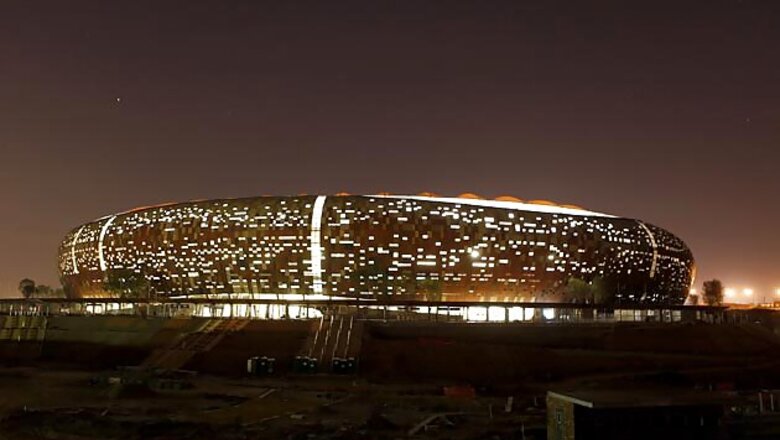
views
Soccer City is 10 kilometres from the Johannesburg city centre, on the outskirts of Soweto, and it will be the major venue at the 2010 World Cup, hosting eight games altogether, including the opening ceremony and match, and the closing ceremony and final. This means that a piece of history will be made as the World Cup is won on July 11 in Africa for the first time, in Soccer City Stadium.
The most striking feature of the stadium is its calabash-shaped design, selected from a number of competing designs. The calabash was picked because it is a uniquely African object and is a recognisable symbol of the African continent. The calabash, or "melting pot of African cultures", sits on a raised podium, on top of which is located a "pit of fire", according to the designers.
Looking at the stadium from the outside is quite an experience, as the towering monster of a venue takes up a massive area and is very imposing indeed, but going into the stadium truly allows one to understand the magnitude of the place. Soccer City is a majestic stadium, and it will be a true gem come July 2010, when the world will be watching South Africa and the World Cup champions will be crowned on a podium in the venue. Africa can be proud of a fine stadium, which will no doubt contribute in a big way to a fine World Cup.
Facts
-City: Johannesburg
-Surface: Grass
-Capacity: 89 000
- 15 000 at parking area around stadium, with 4 055 VIP underground parking
- 300-seat Restaurant
- Football museum
- Media section with 2 451 seats
- The venue has a capacity of 94 700, making it the largest in Africa although attendances will be limited to 89 000 during the World Cup in line with FIFA's security guidelines.
- From an engineering point of view, Soccer City is the biggest roofed stadium to be built for a World Cup.
- Vertical lines within stadium on seats pointing towards nine other stadia in South Africa, and Berlin, where the World Cup was last won.
- Soccer City was recently award top honours at the bi-annual Fulton Awards, which reward constructions for their excellent and innovative use of concrete. Soccer City also won the award for Concrete in Architecture.
History
Formally known as the FNB Stadium, Soccer City was built in 1987 and had distinctive blue and white plastic bucket seats for 80 000 people. A two-metre wide "moat" ran around the entire field to protect players from pitch invasion by spectators. The old stadium, was built after an agreement was reached between the National Professional Soccer League (NPSL) and First National Bank (FNB) to build a football stadium in Nasrec.
The first football game to be played at the massive stadium was appropriately a Soweto derby between Kaizer Chiefs and Orlando Pirates, two of the most popular teams in Johannesburg and South Africa. It was also host of the finals of the African Cup of Nations in February 1996, when the South African national football team beat Tunisia 2-0. The stadium will also be remembered for the mass rally held in 1990 to welcome the release of Nelson Mandela from prison. About 100 000 people swarmed the stadium to hear Mandela call for a unified South Africa.
Pluses and Minuses
Pluses:
* The stadium has 184 suites. The VIP suite is a massive affair that can accommodate 300 people. Private boxes, eight television presentation studios, a football museum and a 300-seat restaurant have also been added to the original Stadium.
* A parking area for 15 000 vehicles will be available for fans by the time the World Cup rolls around.
* A transportation hub is built next to the stadium to facilitate various forms of transport arriving and departing from the stadium precinct.
* There are no bad seats in the venue, as a design allowing for no obstructive views mean that even those in the ‘cheap’ seats at the very top of the 89 000 seat stadium have a fine view of the entire pitch.
* Bathrooms at every turn and concession stands available throughout the stadium means that fans will not need to go very far to buy a snack and drink, or to use the restrooms.
Minuses:
* The stadium will not only be used for football matches, as rugby will be played there as well. This may have a negative impact on the pitch, but no rugby matches are scheduled before the World Cup.
* The amount of seats in the stadium means that at fully packed games, it will take more time than at a smaller venue for everyone to leave their seat and exit the stadium.
Games to be Played
An arena with a seating capacity surpassing that of the new Wembley, the Johannesburg venue will host eight games during the 2010 event, including the opening match between South Africa and Mexico, and of course the final on 11 July. Other matches to be staged at Soccer City include the group games Holland – Denmark, Argentina – Korea Republic, Brazil – Ivory Coast and Ghana – Germany, as well as a second round match and a quarter-final.















Comments
0 comment